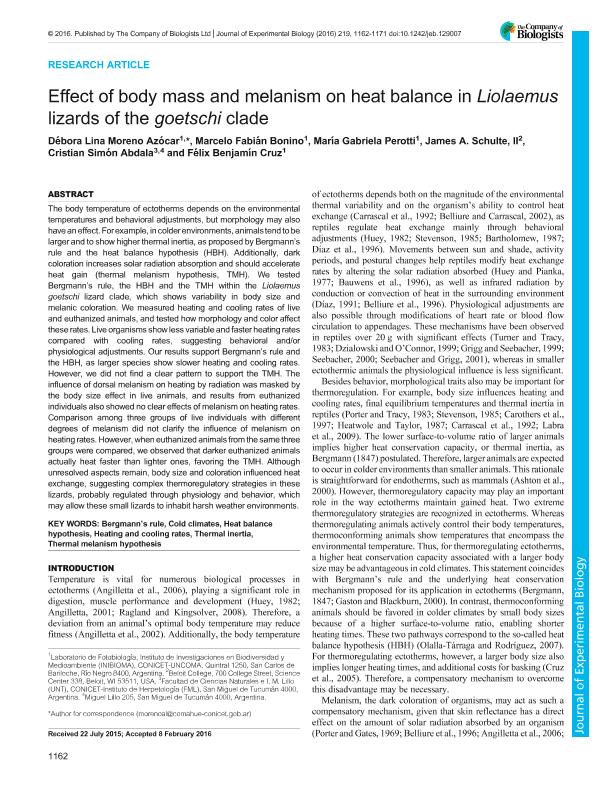Mostrar el registro sencillo del ítem
dc.contributor.author
Moreno Azócar, Débora Lina

dc.contributor.author
Bonino, Marcelo Fabián

dc.contributor.author
Perotti, Maria Gabriela

dc.contributor.author
Schulte, James A.
dc.contributor.author
Abdala, Cristian Simón

dc.contributor.author
Cruz, Felix Benjamin

dc.date.available
2018-08-23T19:37:28Z
dc.date.issued
2016-08
dc.identifier.citation
Moreno Azócar, Débora Lina; Bonino, Marcelo Fabián; Perotti, Maria Gabriela; Schulte, James A.; Abdala, Cristian Simón; et al.; Effect of body mass and melanism on heat balance in Liolaemus lizards of the goetschi clade; Company of Biologists; Journal of Experimental Biology; 219; 8; 8-2016; 1162-1171
dc.identifier.issn
0022-0949
dc.identifier.uri
http://hdl.handle.net/11336/56875
dc.description.abstract
The body temperature of ectotherms depends on the environmental temperatures and behavioral adjustments, but morphology may also have an effect. Forexample, in colder environments, animals tend to be larger and to show higher thermal inertia, as proposed by Bergmann's rule and the heat balance hypothesis (HBH). Additionally, dark coloration increases solar radiation absorption and should accelerate heat gain (thermal melanism hypothesis, TMH). We tested Bergmann's rule, the HBH and the TMH within the Liolaemus goetschi lizard clade, which shows variability in body size and melanic coloration. We measured heating and cooling rates of live and euthanized animals, and tested how morphology and color affect these rates. Live organisms showless variable and faster heating rates compared with cooling rates, suggesting behavioral and/or physiological adjustments. Our results support Bergmann's rule and the HBH, as larger species show slower heating and cooling rates. However, we did not find a clear pattern to support the TMH. The influence of dorsal melanism on heating by radiation was masked by the body size effect in live animals, and results from euthanized individuals also showed no clear effects of melanism on heating rates. Comparison among three groups of live individuals with different degrees of melanism did not clarify the influence of melanism on heating rates.However, when euthanized animals fromthe same three groups were compared, we observed that darker euthanized animals actually heat faster than lighter ones, favoring the TMH. Although unresolved aspects remain, body size and coloration influenced heat exchange, suggesting complex thermoregulatory strategies in these lizards, probably regulated through physiology and behavior, which may allow these small lizards to inhabit harsh weather environments.
dc.format
application/pdf
dc.language.iso
eng
dc.publisher
Company of Biologists

dc.rights
info:eu-repo/semantics/openAccess
dc.rights.uri
https://creativecommons.org/licenses/by-nc-sa/2.5/ar/
dc.subject
Bergmann'S Rule
dc.subject
Cold Climates
dc.subject
Heat Balance Hypothesis
dc.subject
Heating And Cooling Rates
dc.subject
Thermal Inertia
dc.subject
Thermal Melanism Hypothesis
dc.subject.classification
Otras Ciencias Biológicas

dc.subject.classification
Ciencias Biológicas

dc.subject.classification
CIENCIAS NATURALES Y EXACTAS

dc.title
Effect of body mass and melanism on heat balance in Liolaemus lizards of the goetschi clade
dc.type
info:eu-repo/semantics/article
dc.type
info:ar-repo/semantics/artículo
dc.type
info:eu-repo/semantics/publishedVersion
dc.date.updated
2018-08-17T16:56:17Z
dc.journal.volume
219
dc.journal.number
8
dc.journal.pagination
1162-1171
dc.journal.pais
Reino Unido

dc.journal.ciudad
Cambridge
dc.description.fil
Fil: Moreno Azócar, Débora Lina. Consejo Nacional de Investigaciones Científicas y Técnicas. Centro Científico Tecnológico Conicet - Patagonia Norte. Instituto de Investigaciones en Biodiversidad y Medioambiente. Universidad Nacional del Comahue. Centro Regional Universidad Bariloche. Instituto de Investigaciones en Biodiversidad y Medioambiente; Argentina
dc.description.fil
Fil: Bonino, Marcelo Fabián. Consejo Nacional de Investigaciones Científicas y Técnicas. Centro Científico Tecnológico Conicet - Patagonia Norte. Instituto de Investigaciones en Biodiversidad y Medioambiente. Universidad Nacional del Comahue. Centro Regional Universidad Bariloche. Instituto de Investigaciones en Biodiversidad y Medioambiente; Argentina
dc.description.fil
Fil: Perotti, Maria Gabriela. Consejo Nacional de Investigaciones Científicas y Técnicas. Centro Científico Tecnológico Conicet - Patagonia Norte. Instituto de Investigaciones en Biodiversidad y Medioambiente. Universidad Nacional del Comahue. Centro Regional Universidad Bariloche. Instituto de Investigaciones en Biodiversidad y Medioambiente; Argentina
dc.description.fil
Fil: Schulte, James A.. Beloit College; Estados Unidos
dc.description.fil
Fil: Abdala, Cristian Simón. Consejo Nacional de Investigaciones Científicas y Técnicas; Argentina. Fundación Miguel Lillo. Dirección de Zoología. Instituto de Herpetología; Argentina
dc.description.fil
Fil: Cruz, Felix Benjamin. Consejo Nacional de Investigaciones Científicas y Técnicas. Centro Científico Tecnológico Conicet - Patagonia Norte. Instituto de Investigaciones en Biodiversidad y Medioambiente. Universidad Nacional del Comahue. Centro Regional Universidad Bariloche. Instituto de Investigaciones en Biodiversidad y Medioambiente; Argentina
dc.journal.title
Journal of Experimental Biology

dc.relation.alternativeid
info:eu-repo/semantics/altIdentifier/doi/https://dx.doi.org/10.1242/jeb.129007
dc.relation.alternativeid
info:eu-repo/semantics/altIdentifier/url/http://jeb.biologists.org/content/219/8/1162
Archivos asociados
